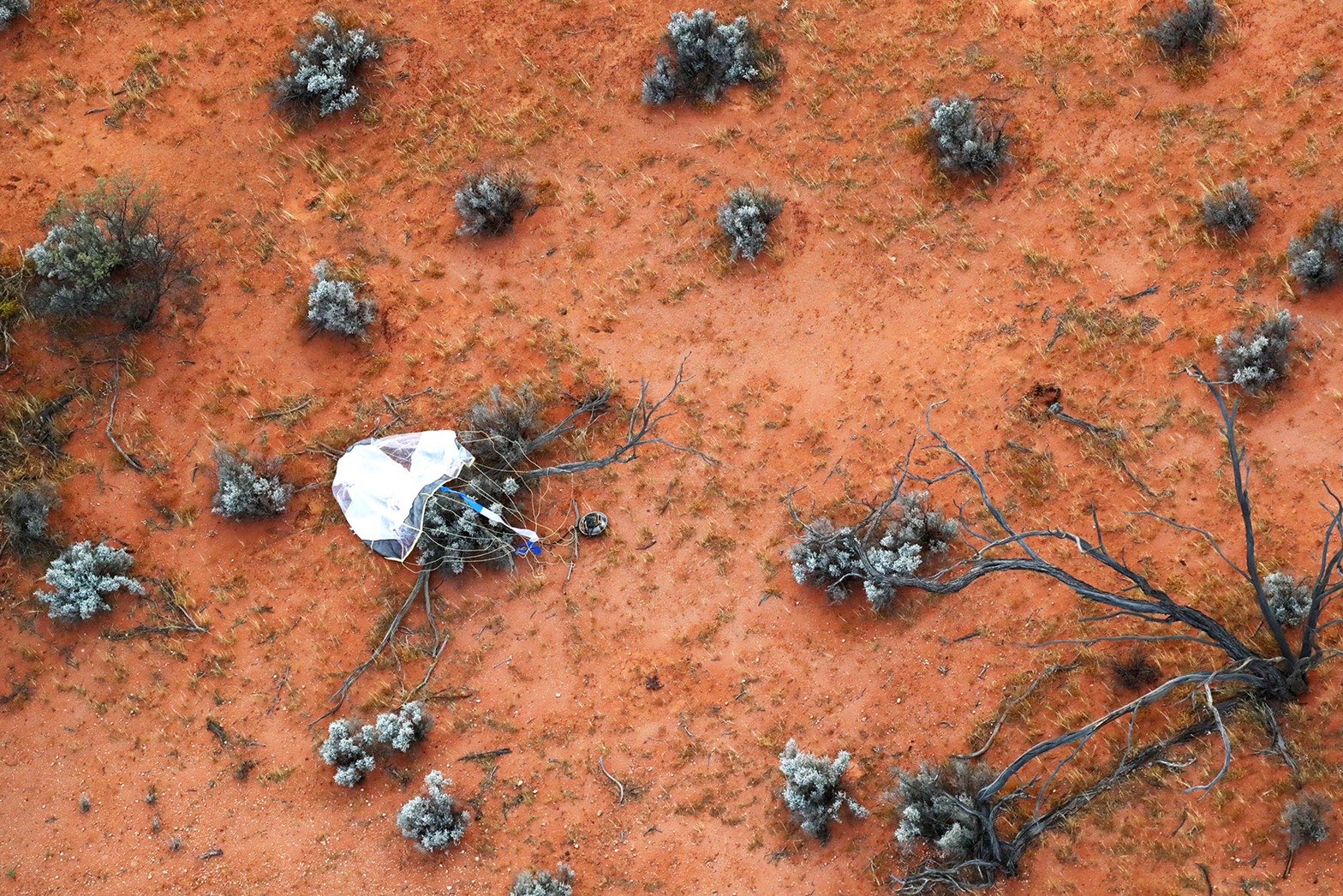Samples of asteroid Ryugu arrive in Japan after successful Hayabusa2 capsule landing
They landed in Australia on Dec. 5.

Japanese scientists are thrilled to finally have asteroid samples arrive Monday (Dec. 7) after a long flight from Australia — and a much longer journey through the solar system.
Those rocks originate on a near-Earth asteroid called Ryugu; the Hayabusa2 spacecraft snagged them in 2019 before a yearlong journey to deliver them to Earth in a small sample-return capsule. The capsule landed on Dec. 5 in the Woomera Prohibited Area in South Australia, creating a stunning fireball in the pre-dawn skies. Japanese scientists on site successfully tracked down the capsule and collected the precious cosmic delivery to begin the final leg of its journey.
"The dream has come true," Hitoshi Kuninaka, director general of the Institute of Space and Astronautical Science at the Japan Aerospace Exploration Agency (JAXA), which runs the Hayabusa2 mission, said during a news conference held Dec. 5 in Japan.
Related: Japan's Hayabusa2 asteroid Ryugu sample-return mission in pictures
The Hayabusa2 spacecraft left Ryugu in November 2019 after snagging samples from the asteroid's surface and interior. The main spaceship parted ways with the return capsule just two days before the delivery was complete and retreated to begin work on its extended mission, which will feature encounters with two more asteroids, in 2026 and 2031.
Meanwhile, scientists in Australia waited for the distinctive fireball the capsule would create on its way in through the atmosphere. "The weather was crystal clear," Yuichi Tsuda, project manager for Hayabusa2, said during the news conference of the weather at the capsule's arrival. The fireball streaked through the Southern Cross and near Alpha Centauri, according to officials during the news conference.
Look at this marvelous photo of the Hayabusa2 reentry, taken in Cooper Pedy, nearby the capsule landing site, Woomera, Australia. pic.twitter.com/EBwHtcZ5YzDecember 6, 2020
But the stunning re-entry fireball images that observers were able to capture nearly didn't exist. A storm passed through the area the day before, and scientists worried that the weather would make the retrieval process more difficult. "One day before there was heavy rain; we were very lucky," Satoru Nakazawa, recovery manager for the mission, said during the news conference.
Breaking space news, the latest updates on rocket launches, skywatching events and more!
Although the weather cleared, there was still a tense moment during the recovery, he said. The sun hadn't yet risen when the capsule landed, which made its beacon signal less clear to waiting receivers. "I was very, very, very nervous and uneasy," Nakazawa said. "We had to spend a very jittering frustrating time until the sun rose."
PM Suga: I am truly delighted at the successful retrieval of the capsule returned to earth by #Hayabusa2 @haya2e_jaxa space probe, which has traveled in space for six years since its launch. I extend my respect to Professor Tsuda, the project manager who led it to success (1/2) pic.twitter.com/yP0lIJ1Ep0December 7, 2020
Once the sun rose, the scientists could see the capsule for themselves, perfectly within the planned landing area and crashed next to a bush on Woomera's red soil. JAXA personnel carefully untangled the parachute, bush and capsule, Nakazawa explained, cautious in case any explosive parachute triggers remained loaded.
After the initial inspection, about two dozen staff jumped into action, ferrying the spacefaring capsule into a box for safekeeping, then to a helicopter that carried it to the team's headquarters. There, scientists attempted to draw a gas sample from the capsule, which may still contain gases from Ryugu itself.
Capsule collection! The helicopter team immediately flew to the location identified by the DFS team. They searched for the fallen capsule by using radio waves and maps. Thank you very much!(Collection Team M)#Hayabusa2#はやぶさ2#AsteroidExplorerHayabusa2 #HAYA2Report pic.twitter.com/KSyEbnU3YdDecember 6, 2020
But the clock was ticking: The Hayabusa2 team wanted the sample in Japan within 100 hours of its return to Earth in order to keep the space rock pristine. So the capsule's next destination was an airplane for a nine-hour flight from Australia to Japan on Monday.
"There the sample will start to tell its stories and reveal to us some wonderful science," Megan Clark, head of the Australian Space Agency, said during the news conference. "2020 has been a difficult year all around the world, but Hayabusa2 and the safe return of the capsule reminds us to renew our faith in the world and our trust and appreciation and awe in the science of our universe."
We observed the capsule re-entry from around Coober Pedy, with the assistance of Curtin Observatory. The observation was successful & here is our image!https://t.co/KTdV0G9moUCredit: Curtin University, Kouchi University of Technology, Nihon University, Ibaraki University, JAXA pic.twitter.com/qTFW8I8UD9December 6, 2020
Even before setting eyes on the sample themselves, scientists with the mission are thrilled about the successful collection procedure and the scientific discoveries that will result.
"Hayabusa2 is home. It has finished six years of voyage and we landed in the Woomera and we could collect the treasure box," Tsuda said. (The mission launched in December 2014.) "Hayabusa2 is still in perfect shape and the capsule is also perfect … We're really looking forward to seeing that capsule."
Email Meghan Bartels at mbartels@space.com or follow her on Twitter @meghanbartels. Follow us on Twitter @Spacedotcom and on Facebook.

Meghan is a senior writer at Space.com and has more than five years' experience as a science journalist based in New York City. She joined Space.com in July 2018, with previous writing published in outlets including Newsweek and Audubon. Meghan earned an MA in science journalism from New York University and a BA in classics from Georgetown University, and in her free time she enjoys reading and visiting museums. Follow her on Twitter at @meghanbartels.
